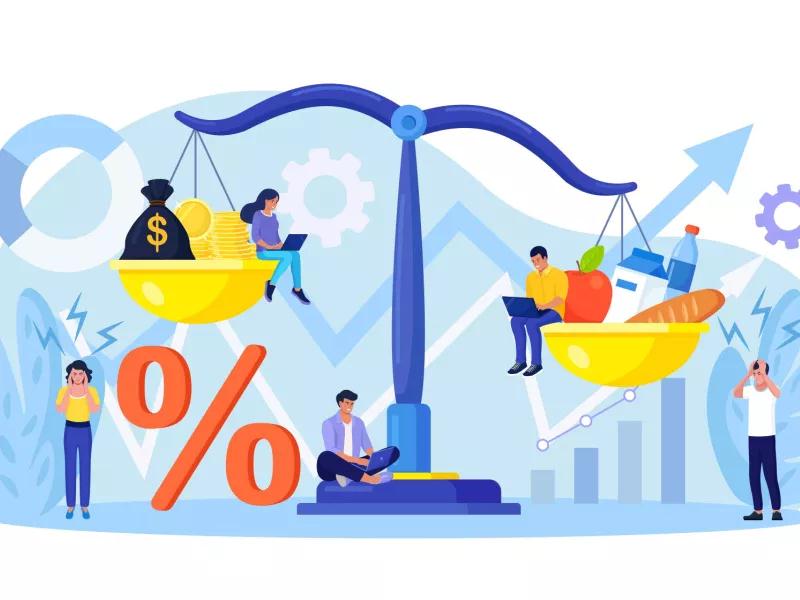Return on Investment (or Return on Investment, ROI) or also called return on investment, is a performance measure used to evaluate the efficiency of an investment or to compare the efficiency of a number of different investments.
Return on Investment attempts to directly measure the amount of return on a specific investment, relative to its investment cost. To calculate return on investment, the benefit – or return – of an investment is divided by the cost of the investment. The result is expressed as a percentage or a ratio.
How to calculate return on investment
The ROI follows the following formula:
ROI = (Present value of investment – Cost of investment) / Cost of investment
The “Present value of the investment” refers to the total benefits obtained by carrying out one’s investment transactions with an initial capital plus the invested capital. Because ROI is measured as a percentage, it can easily be compared to the returns offered by other investments, allowing a variety of investment types to be measured against each other.
Purpose of the ROI Metric
In business, the purpose of the return on investment (ROI) metric is to measure, by period, the rates of return on money invested in an economic entity to decide whether or not to make an investment. It is also used as an indicator to compare different investments within a portfolio.
The investment with the largest ROI is usually prioritized, although the spread of ROI over the time period of an investment must also be taken into account. Recently, the concept has also been applied to investments by scientific funding agencies (e.g., the National Science Foundation) in open source hardware research and subsequent returns for direct digital replication.
Return on investment and related metrics provide a snapshot of profitability, adjusted for the size of investment assets tied to the company. ROI is often compared to the expected (or required) rates of return on money invested. ROI is not time-adjusted (unlike, for example, net present value): most textbooks describe it with a “Year 0” investment and an income of two to three years.
Marketing decisions have an obvious potential connection to the ROI (profit) numerator, but these same decisions often influence asset usage and capital requirements (for example, accounts receivable and inventories). Marketers must understand their company’s position and expected returns. In a survey of nearly 200 senior marketing managers, 77 percent responded that they found the “return on investment” metric very useful.
Return on investment can extend to terms other than financial gains. For example, social return on investment (SROI) is a principles-based method of measuring extra-financial value (i.e., environmental and social value not currently reflected in conventional financial accounts) relative to the resources invested. . It can be used by any entity to assess impact on stakeholders, identify ways to improve performance, and improve return on investments.
Understanding the concept
ROI is a popular measure due to its versatility and simplicity. Essentially, ROI can be used as a rudimentary snapshot of the profitability of an investment. This could be the return on a stock investment, the ROI on a real estate transaction. The calculation itself is not that complicated, and is relatively easy to interpret across a range of applications.
If an investment has a positive net ROI, it is probably a valuable investment. But if other opportunities with higher ROIs are available, this signals that it can help investors eliminate or select the best options. Likewise, investors should avoid ROIs with negative returns, which imply net losses.
For example, suppose Diego invested $1,000 in Pizzas de la Montaña Co. in 2017 and sold his shares for a total of $1,200 a year later. To calculate his return on his investment, he should divide his profits ($1200 – $1000) by the cost of the initial investment ($1000). So the return on investment will be $200/$1,000, or 20, which is an ROI of 20 percent.
With this information, Diego could compare his investment in Pizzas de la Montaña Co. with his other projects. Suppose Diego also invested $2,000 in Grandes Tiendas Inc. in 2014 and sold his shares for a total amount of $2,800 in 2017. Diego’s ROI on Grandes Tierras Inc. would be $800/$2,000, or 40 percent . (See ROI limitations below for potential problems that arise when contrasting time structures.)
Limitations of ROI
Examples like Diego’s (above) reveal some limitations of using ROI, particularly when comparing investments. While Diego’s ROI on the second investment is twice what it was on his first investment. The time between the purchase and sale of Diego’s investment in the first investment was one year and three years in the second.
Diego could adjust the ROI of his multi-year investment so that it can be compared to the annual investment. Since the three-year ROI of the investment was 40 percent, to get the average annual ROI, he could divide 40 percent by 3, which would give us a return of 13.33 percent. With this adjustment, we can see that although Diego’s second investment generated more profits, his first investment was actually the most efficient.
ROI can be used in conjunction with the rate of return, which takes into account a project and its time structure. One could also use net present value, which accounts for differences in the time value of money due to inflation. The application of net present value when calculating the rate of return is what we call the Real Rate of Return.
Risk with the use of the Return on Investment metric
As a decision tool, it is easy to understand. The simplicity of the formula allows users to freely choose variables, for example the length of calculation time, whether the overhead cost is included, or what factors are used to calculate revenue or cost components. Using ROI as an indicator to prioritize investment projects is risky, since the ROI figure is generally not accompanied by an explanation of its composition.
For long-term investments, the need for net present value adjustment is great. Similar to discounted cash flow, a discounted ROI should be used.
One of the biggest risks associated with the traditional ROI calculation is that it does not “fully capture the short- or long-term importance, value, or risks associated with natural and social capital” because it does not take into account environmental, social, and performance. governance of an organization. Without a metric to measure a company’s short- and long-term environmental, social, and governance performance, decision makers are planning for the future without considering the scope of impacts associated with their decisions.
Developments in ROI
Recently, certain investors and businesses have developed some interest in a new way of measuring ROI, called “Social Return on Investment” or SROI. SROI was initially developed in the early 2000s and takes into account broader impacts of projects using extra-financial values (for example, social and environmental measures that are not currently reflected in conventional financial accounts). SROI helps understand the value proposition of certain ESG (Environmental, Social and Governance) investments with criteria that can be used in socially responsible investment practices. For example, a company may undertake water recycling in its factories and replace lighting with LED bulbs. These ventures have immediate costs that can negatively affect the ROI according to traditional measures. However, the net benefit for society and the environment can lead to a positive SROI (Social Return on Investment).
There are various other measures or new “flavors” of ROI that have been designed for particular purposes.
Social media ROI statistics point to the effectiveness of social media campaigns – For example, how many clicks or “likes” are generated with a given unit of effort. Likewise, marketing campaign ROI statistics attempt to identify the return attributable to marketing or advertising campaigns.
Similarly, the so-called ROI is also related to the amount of information learned and retained as a return in an education or skills training process.
As the world progresses and the economy changes, several more forms of ROI will surely be developed in the future.











